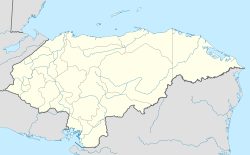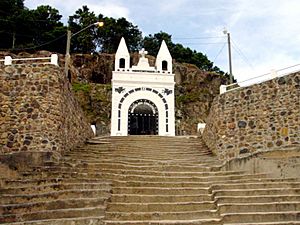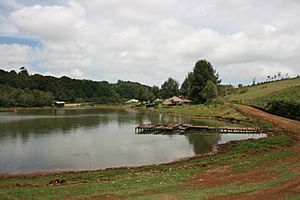La Esperanza, Honduras facts for kids
Quick facts for kids
La Esperanza
|
|
|---|---|
| Nickname(s):
La Esperansita
|
|
| Country | |
| Department | Intibucá |
| Founded | 22 September 1848 |
| City and Municipality | 1883 |
| Government | |
| • Type | Democratic Municipality |
| Area | |
| • Total | 157.2 km2 (60.7 sq mi) |
| Elevation | 1,700 m (5,600 ft) |
| Population
(2016)
|
|
| • Total | 12,955 |
| • Density | 82.411/km2 (213.44/sq mi) |
| Time zone | UTC-6 (Central America) |
| Postal code |
14101
|
| Municipality number | 1001 |
| Website | Official web page (possibly abandoned): https://web.archive.org/web/20110501133225/http://www.intibucalaesperanza.hn/ |
La Esperanza is a cool city in Honduras. It is the capital of the Intibucá area. La Esperanza is known for having the coolest weather in Honduras. It is also a key part of the Ruta Lenca, which is a special trail that celebrates the Lenca people and their culture. This trail helps people learn about Lenca traditions and supports their crafts.
The city of La Esperanza is right next to another city called Intibucá. They are so close that they almost look like one big city. Intibucá is older and was originally a Lenca community. La Esperanza is newer and was settled by Ladino people. Even though they have separate governments, many people just call the whole area "La Esperanza."
Contents
History of La Esperanza
The area where La Esperanza is today was first lived in by the Maya and Lenca people a very long time ago. They had two settlements called Eramani and Lentercala. In 1647, a Spanish official named Francisco de La Cerda marked the land for the local people. He divided the land into two parts and named the small communities around them.
Over time, the two areas grew and became rivals, especially over land. The cities got bigger, especially in the 1800s. La Esperanza officially became a city in 1883. This happened when the Intibucá department was created, separating from the Lempira department.
In 2002, a company started building a hydroelectric dam on the Rio Intibucá. This dam, called the La Esperanza Hydro Project, began making electricity in 2003. It was fully finished in 2006. This project was the first in the world to earn special credits for reducing pollution.
Geography of La Esperanza
La Esperanza is located very high up, at 1700 meters (about 5,577 feet). This makes it the highest city in Honduras. The Rio Intibucá river flows through the city. La Esperanza is in a flat mountain valley. It is surrounded by two mountain ranges: the Sierra de Puca Opalaca to the north and Montaña Zapochoco to the southeast. The La Esperanza municipality covers 138.8 square kilometers (about 53.6 square miles).
The La Esperanza Airport is about 2 kilometers (1.2 miles) south of the cities.
Climate in La Esperanza
La Esperanza has two main seasons each year. The rainy season, or winter, lasts from May to October. The dry season, or summer, is from November to April. June and September are the rainiest months. February and March are the driest. During winter, it often rains in the afternoons. Heavy rain can make dirt roads to mountain communities hard to use.
Because it is so high up, La Esperanza has a cooler climate than most of Honduras. The average temperature is about 18.1 °C (64.5 °F). In December and January, nighttime temperatures can drop to around 4°C (40s °F). Sometimes, hail falls, but it has never snowed. In the summer, temperatures can reach the 20s °C (80s °F), but the air is not very humid.
| Climate data for La Esperanza, Honduras (1989-2024) | |||||||||||||
|---|---|---|---|---|---|---|---|---|---|---|---|---|---|
| Month | Jan | Feb | Mar | Apr | May | Jun | Jul | Aug | Sep | Oct | Nov | Dec | Year |
| Record high °C (°F) | 36.6 (97.9) |
33.0 (91.4) |
31.7 (89.1) |
32.0 (89.6) |
31.0 (87.8) |
34.0 (93.2) |
32.0 (89.6) |
32.8 (91.0) |
31.0 (87.8) |
29.0 (84.2) |
33.0 (91.4) |
29.6 (85.3) |
36.6 (97.9) |
| Mean daily maximum °C (°F) | 21.5 (70.7) |
23.1 (73.6) |
24.6 (76.3) |
25.6 (78.1) |
24.9 (76.8) |
24.1 (75.4) |
23.7 (74.7) |
24.0 (75.2) |
24.0 (75.2) |
22.6 (72.7) |
21.3 (70.3) |
21.1 (70.0) |
23.4 (74.1) |
| Daily mean °C (°F) | 16.0 (60.8) |
16.8 (62.2) |
17.9 (64.2) |
19.1 (66.4) |
19.5 (67.1) |
19.1 (66.4) |
18.8 (65.8) |
19.0 (66.2) |
19.0 (66.2) |
18.3 (64.9) |
17.0 (62.6) |
16.1 (61.0) |
18.1 (64.5) |
| Mean daily minimum °C (°F) | 10.5 (50.9) |
10.5 (50.9) |
11.2 (52.2) |
12.6 (54.7) |
14.0 (57.2) |
14.1 (57.4) |
13.9 (57.0) |
13.9 (57.0) |
14.1 (57.4) |
13.9 (57.0) |
12.7 (54.9) |
11.2 (52.2) |
12.7 (54.9) |
| Record low °C (°F) | 1.0 (33.8) |
−0.3 (31.5) |
1.5 (34.7) |
5.0 (41.0) |
6.5 (43.7) |
7.0 (44.6) |
8.4 (47.1) |
8.5 (47.3) |
9.2 (48.6) |
7.8 (46.0) |
3.7 (38.7) |
0.5 (32.9) |
−0.3 (31.5) |
| Average precipitation mm (inches) | 12.6 (0.50) |
5.8 (0.23) |
6.4 (0.25) |
36.0 (1.42) |
114.4 (4.50) |
178.1 (7.01) |
87.2 (3.43) |
140.3 (5.52) |
190.9 (7.52) |
123.6 (4.87) |
34.4 (1.35) |
9.3 (0.37) |
939.0 (36.97) |
| Average precipitation days (≥ 1.0 mm) | 1.0 | 1.1 | 1.3 | 3.7 | 9.2 | 14.1 | 10.4 | 12.2 | 15.4 | 10.7 | 4.4 | 1.6 | 85.2 |
| Source: NOAA | |||||||||||||
Population of La Esperanza
In 2018, about 13,800 people were expected to live in La Esperanza. About 9,900 of them lived in the city area, and 3,900 lived in the countryside. If you combine La Esperanza with the nearby city of Intibucá, the total city population is about 37,600 people.
Who Lives in La Esperanza?
According to a 2013 census, La Esperanza municipality had 11,631 people.
- 59.11% were Indigenous (mostly Lenca people).
- 36.91% were Mestizo (people of mixed European and Indigenous heritage).
- 3.18% were White.
- 0.55% were Afro-Honduran or Black.
- 0.26% were from other groups.
Towns and Hamlets in La Esperanza
The municipality has five main villages, called aldeas. These villages include 36 smaller communities, called caseríos.
- La Esperanza
- El Terrero
- Finca Las Terrazas o El Refugio
- Finca San José Del Edén
- Finca Santa Anita
- La Laguna
- La Pozona
- Las Anonas
- Lepaterique
- San Esteban
- Tierra Colorada
- Los Diez Chorritos
- Piedra Menuda
- El Invernadero
- Chogola
- Chogola
- Agua Blanca
- El Arenal
- El Mango o Las Pilas
- Hda. de Quiala
- Llano de La Cruz
- Quiala
- Puente Hondo
- La Sierra
- El Pelón
- El Pelón
- Llano Chalingua
- La Pimienta
- La Pimienta
- El Garrapatero
- Nueva Esperanza
- Nueva Esperanza
- El Pastal
- El Pital
- La Montaña
- San Antonio
- San Juan o Los Roquitos
- San Vicente
- Palos Blancos
Culture in La Esperanza
The main group of people in La Esperanza are the Lenca people. They have lived in this part of Honduras since before Christopher Columbus arrived. The Lenca are the largest Indigenous group in Honduras, with over 100,000 members. They once had their own language, but it is no longer spoken. However, they still keep their traditional customs and arts alive. These include making textiles and pottery, performing special dances, and wearing unique clothing. Lenca women often wear brightly colored dresses and woven head scarves called pañuelos.
Life in La Esperanza and Intibucá mostly revolves around farming. This is how most people, especially the Lenca, make a living. Because of its cool climate, the area can grow special crops that other parts of Honduras cannot. These include potatoes, strawberries, and apples.
La Esperanza is famous for its daily farmers market. Farmers from nearby Lenca communities come to sell their fruits and vegetables in the street. Some local people also have permanent wooden stalls. You can find many fresh foods like lettuce, carrots, broccoli, potatoes, tomatoes, apples, and strawberries. The busiest market days are Saturday and Sunday.
Celebrations and Festivals
Most people in Honduras are Roman Catholic, and many are also Evangelical Christians. Because of this, Christmas (Navidad) and Holy Week (Semana Santa) before Easter are very important times for celebrations. On Christmas Eve (Nochebuena), families and friends have a late dinner and light fireworks at midnight.
During Holy Week, there are many parades and activities. Good Friday (Viernes Santo) has the biggest parade. People create beautiful alfombras (carpets) on the street using colored sawdust. Most businesses close on Thursday and Friday of Holy Week, which are national holidays.
Besides Christmas and Easter, people in La Esperanza celebrate other festivals:
- Artisan Festival (Feria de Artesanía de La Ruta Lenca) – February
- Anniversary of the Department of Intibucá – 16 April
- National Mushroom and Wine Festival (Festival Nacional del Choro y el Vino) – June or July
- Potato Festival (Feria de La Papa) – July
- El Grande de Grandes (International traditional dance competition) – the last Saturday in October
- Independence from Spain (Día de Independencia) – 15 September
- Festival of the Patron Saint, Virgin of Conception (Feria Patronal de la Virgen de Concepcion) – 29 November to 7 December
These festivals often include parades, marching bands, food stalls, craft shows, traditional dancing, live music, and fireworks.
Local Crafts and Products
Local people in La Esperanza make many beautiful handmade items. Women's groups use wooden looms to create traditional Lenca textiles. These include ponchos, scarves, and tablecloths in bright colors. Other groups use pine needles from the forests to weave strong and pretty baskets and vases. White clay from the area is used to make unique ceramic items.
La Esperanza is also known for its sweet, fruit-flavored wines. These wines are made from fruits like strawberries, pears, peaches, and apples. They even make wine from potatoes! Visitors can buy these crafts and wines at souvenir stores in town, such as UMMIL, Opalacas, and El Rincon del Turista.
National Capital of Honduran Folklore
On July 23, 2013, La Esperanza was named the national capital of Honduran folklore. This was to honor Rafael Manzanares Aguilar, a famous folklorist, author, and musician from La Esperanza. He started the Cuadro Nacional De Danzas Folklóricas de Honduras (National Folkloric Dance Group of Honduras). He helped bring back many traditional folklore customs in Honduras.
Every year, La Esperanza celebrates this title with the "El Grande de Grandes" folklore festival. Dance groups from all over Honduras come to perform their regional dances and show off their traditional costumes.
Tourism in La Esperanza
La Esperanza is a good place to stop if you are traveling between Tegucigalpa and Western Honduras. It is part of the Ruta Lenca, which is a special route for cultural tourism. La Esperanza and Intibucá have many hotels, restaurants, and shops for all budgets.
Here are some interesting places to visit in and around La Esperanza:
- La Gruta – This is a cave on a small hill overlooking the town. It is a short walk from the Central Park. La Gruta is a shrine to the Virgin of the Immaculate Conception. You climb 31 steps carved from volcanic stone to reach it. Religious ceremonies and cultural events happen here. People say a man named J. Inés Pérez built it to keep a promise after hiding in the cave from his enemies. From the top, you get a great view of the city.
- Lenca Cultural Museum – This museum is in the Casa de Cultura, a large pink building near the Central Park. It is open Monday to Friday, usually from 12 PM to 4 PM. You can see old items, local crafts, and learn a lot about the history and culture of the Lenca people. You can even ask for a guide if you plan ahead.
- Baños Publicos El Quiscamote (Public Baths) – This is a place where people wash clothes at public water taps. It also has a small swimming pool and picnic tables. It is a 15-minute walk from town.
- Lenca Market – This market sells fresh produce, meat, cheese, household items, clothes, and other small treasures. It is located a few blocks north of the Intibucá Municipal Building.
- Parque de Bosque Enano (Dwarf Forest) – A short drive from town on the road to Marcala, this forest has over 500 unique dwarf trees. These trees grow less than half a meter (about 1.6 feet) tall. Scientists are still not sure why they are so small, but it is a very interesting sight! There are no signs, so you might need to ask a local for directions.
- Laguna de Madre Vieja (Lagoon of the Old Mother) – This small lagoon is on the left side of the road just before you enter town, if you are coming from Siguatepeque. You can fish, rent a rowboat, or just enjoy the quiet.
- Laguna de Chiligatoro (Lagoon of Chiligatoro) – This lagoon is about 30 minutes by bus from La Esperanza. It is a great place to relax, swim, or rent a rowboat. There is a restaurant nearby with local food. A few kilometers further, you can visit the women of El Cacao to watch them make traditional woven textiles.
- Estadio Romualdo Bueso – This is the main sports stadium in La Esperanza. It is the home field for the Atlético Esperanzano soccer team and the Lenca Rugby Club. The stadium can hold 3,000 people.
- Ballet Folklórico Oro Lenca – This dance group performs traditional dances in colorful costumes during festivals and holidays. They are based at the Casa de Cultura and also host a national folk dance festival in La Esperanza every October.
Transportation to La Esperanza
You can easily reach La Esperanza by car or bus from Siguatepeque using Highway 22. This road is paved and in good condition. From La Esperanza, you can take a road to Yamaranguila and connect to Highway CA 11-A. This road leads to San Juan, Intibucá; Gracias, Lempira; and Santa Rosa de Copán, Copan. Parts of the road between La Esperanza and San Juan are unpaved, so they can be difficult to use during the rainy season. However, this road is currently being paved.
Transportes Carolina runs comfortable buses every hour to and from Tegucigalpa and San Pedro Sula. These buses stop in major cities along the way. There are also regular mini-bus services to Marcala, Yamaranguila, San Juan, Erandique, Gracias, and Santa Rosa de Copan. These all leave from the main bus station near the town entrance. Smaller local buses, sometimes called chicken buses, go to the smaller communities around La Esperanza.
The nearby village of San Juan is known for growing coffee. It is also close to Erandique, where you can find the ancient fortress of Lempira. Lempira was an Indigenous Honduran hero who fought against the Spanish.
Notable People from La Esperanza
- Berta Caceres (Lenca) – A leader who worked to protect the environment and human rights.
- Nelson Gracias (Lenca) – An activist who worked to protect the environment.
- Rafael Manzanares Aguilar – A famous Honduran folklorist, author, and music composer. He started the National Office of Folklore of Honduras and the National Folkloric Dance Group of Honduras.
- Vicente Mejía Colindres – He was the president of Honduras in 1919 and again from 1929 to 1933. He was known for peaceful transfers of power between different political parties.
See also
 In Spanish: La Esperanza (Intibucá) para niños
In Spanish: La Esperanza (Intibucá) para niños






